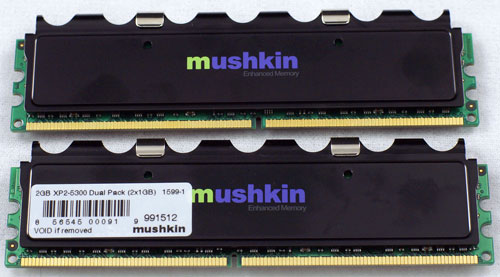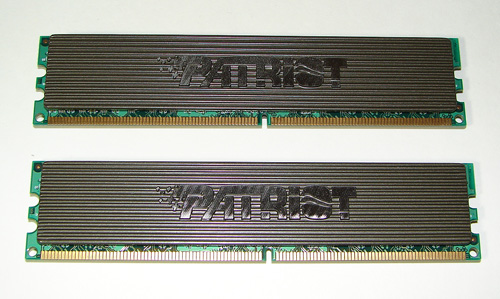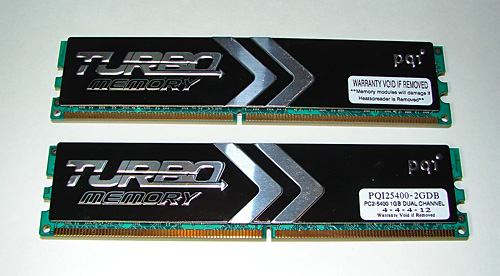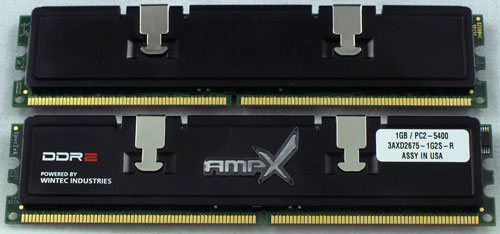Conroe Buying Guide: Feeding the Monster
by Gary Key & Wesley Fink on July 19, 2006 6:20 AM EST- Posted in
- Motherboards
Mushkin eXtreme DDR2-667

The Mushkin DDR2-667 memory arrived with the highest price in our value roundup, an excellent heat spreader design, but performed below average at the DDR2-667 and DDR2-800 settings. We raised the voltages but did not have any success in improving the timings at these settings. However, the Mushkin ran at stock voltages for the low latency DDR2-400 and DDR2-533 settings although the 3-3-3-8 timings at DDR2-533 could not be improved with additional voltage to match the 3-2-2-7 timings of other modules. Also, this is the only memory in our group that would not run 4-3-3 settings at DDR2-800. Although the performance difference is minimal, the cost of this kit indicates the memory should perform better.
Patriot DDR2-667

Patriot Memory provided their Extreme Performance series memory modules that provided above average performance at voltage settings that were more than acceptable for 24/7 operation. The memory comes with stylish heat spreaders and was able to easily clock up to DDR2-900 at extended voltages and 5-5-5-15 timings, though we recommend the lower latencies at DDR2-800.
PQI Turbo DDR2-667

The bargain of the bunch has to be the PQI Turbo kit that is currently selling for around $117 with rebate. While the timing performance of the memory was excellent we had to run at voltages higher than the group's average to meet these settings. The base voltage for this particular model is 2.0V, something to be aware of based upon our results with the other memory modules.
Wintec AMPX DDR2-667

The Wintec AMPX DDR2 Extreme series of memory was the pleasant surprise of the group as it generated excellent timings at low voltages at the lower memory speeds. It performed average at DDR2-800, although the results are more than acceptable.
Comparing Value Memory
All of the memory in the value section was able to run on average 4-3-3-9 settings at DDR2-800 except for the Mushkin modules that were limited to 4-4-4-12 but at a low 2.0V setting. The performance delta is extremely minor and the lower voltages are welcomed, but the Mushkin memory is the most expensive in our group so we naturally expect more from it.
The ability of all our value memory to run at very low latencies at DDR2-667 and 4-3-3-9 latencies at DDR2-800 is just incredible given the average price of $148 for a 2GB kit. Not even a year ago this type of performance in the DDR2 world would have placed this "value" memory at the top of performance charts. We found the Elpida memory to offer higher overclocks at lower memory voltages overall than the Infineon based modules, making it the current leader in value performance memory in our opinion.
The two modules that stood out were the A-Data Vitesta DDR2-533 and Wintec AMPX DDR2-667. During testing, both offered a unique combination of price, performance, and stability. All of the memory reviewed is more than acceptable for a Conroe system and the performance differences are so minor that we suggest choosing a supplier based upon prior experience, warranty, or price in this case. We will be looking at additional value memory modules from other suppliers shortly along with providing performance test results with our new Core 2 Duo Memory test platform.

The Mushkin DDR2-667 memory arrived with the highest price in our value roundup, an excellent heat spreader design, but performed below average at the DDR2-667 and DDR2-800 settings. We raised the voltages but did not have any success in improving the timings at these settings. However, the Mushkin ran at stock voltages for the low latency DDR2-400 and DDR2-533 settings although the 3-3-3-8 timings at DDR2-533 could not be improved with additional voltage to match the 3-2-2-7 timings of other modules. Also, this is the only memory in our group that would not run 4-3-3 settings at DDR2-800. Although the performance difference is minimal, the cost of this kit indicates the memory should perform better.
| Mushkin - DDR2-667 - 2x1GB Model # 991512 |
||
| CPU Ratio | Memory Speed |
Best Memory Timings (Voltage) |
| (4:3) | 400 DDR2 | 3-2-2-5 1.8V |
| (1:1) | 533 DDR2 | 3-3-3-8 1.8V |
| (4:5) | 667 DDR2 | 3-3-3-10 2.1V |
| (2:3) | 800 DDR2 | 4-4-4-12 2.0V |
Patriot DDR2-667

Patriot Memory provided their Extreme Performance series memory modules that provided above average performance at voltage settings that were more than acceptable for 24/7 operation. The memory comes with stylish heat spreaders and was able to easily clock up to DDR2-900 at extended voltages and 5-5-5-15 timings, though we recommend the lower latencies at DDR2-800.
| Patriot - DDR2-667 - 2x1GB Model # PDC22G5300LLK |
||
| CPU Ratio | Memory Speed |
Best Memory Timings (Voltage) |
| (4:3) | 400 DDR2 | 3-2-2-5 1.9V |
| (1:1) | 533 DDR2 | 3-2-3-7 1.9V |
| (4:5) | 667 DDR2 | 3-3-3-8 2.1V |
| (2:3) | 800 DDR2 | 4-3-3-8 2.1V |
PQI Turbo DDR2-667

The bargain of the bunch has to be the PQI Turbo kit that is currently selling for around $117 with rebate. While the timing performance of the memory was excellent we had to run at voltages higher than the group's average to meet these settings. The base voltage for this particular model is 2.0V, something to be aware of based upon our results with the other memory modules.
| PQI - DDR2-667 - 2x1GB Model # PQI25400-2GDB |
||
| CPU Ratio | Memory Speed |
Best Memory Timings (Voltage) |
| (4:3) | 400 DDR2 | 3-2-2-5 2.0V |
| (1:1) | 533 DDR2 | 3-2-2-7 2.0V |
| (4:5) | 667 DDR2 | 3-2-3-9 2.2V |
| (2:3) | 800 DDR2 | 4-3-3-9 2.2V |
Wintec AMPX DDR2-667

The Wintec AMPX DDR2 Extreme series of memory was the pleasant surprise of the group as it generated excellent timings at low voltages at the lower memory speeds. It performed average at DDR2-800, although the results are more than acceptable.
| Wintec AMPX - DDR2-667 - 2x1GB Model # 3AXD2675-1G2S-R |
||
| CPU Ratio | Memory Speed |
Best Memory Timings (Voltage) |
| (4:3) | 400 DDR2 | 3-2-2-5 1.8V |
| (1:1) | 533 DDR2 | 3-2-2-7 1.9V |
| (4:5) | 667 DDR2 | 3-3-3-8 2.15V |
| (2:3) | 800 DDR2 | 4-3-3-9 2.2V |
Comparing Value Memory
All of the memory in the value section was able to run on average 4-3-3-9 settings at DDR2-800 except for the Mushkin modules that were limited to 4-4-4-12 but at a low 2.0V setting. The performance delta is extremely minor and the lower voltages are welcomed, but the Mushkin memory is the most expensive in our group so we naturally expect more from it.
The ability of all our value memory to run at very low latencies at DDR2-667 and 4-3-3-9 latencies at DDR2-800 is just incredible given the average price of $148 for a 2GB kit. Not even a year ago this type of performance in the DDR2 world would have placed this "value" memory at the top of performance charts. We found the Elpida memory to offer higher overclocks at lower memory voltages overall than the Infineon based modules, making it the current leader in value performance memory in our opinion.
The two modules that stood out were the A-Data Vitesta DDR2-533 and Wintec AMPX DDR2-667. During testing, both offered a unique combination of price, performance, and stability. All of the memory reviewed is more than acceptable for a Conroe system and the performance differences are so minor that we suggest choosing a supplier based upon prior experience, warranty, or price in this case. We will be looking at additional value memory modules from other suppliers shortly along with providing performance test results with our new Core 2 Duo Memory test platform.










123 Comments
View All Comments
Gary Key - Thursday, July 20, 2006 - link
Thank you for the comments. Our focus on the first cooler roundup will be on units that cost under $25 but the Tuniq will be included as a reference point along with the retail Intel unit. Our follow up will include the high end air coolers and some water cooling units.The Tuniq is considered to be one of the best air coolers available at this time although we are starting to see this design being incorporated by other suppliers quickly.
biggersteve - Tuesday, September 19, 2006 - link
Hope you can get an Arctic Cooler Pro 7 into that cooler review. Quiet as a tomb and mighty cool.jonmcguffin - Thursday, July 20, 2006 - link
A feature built into the Core 2 Duo processors is this new Digital Thermal Sensor that supposedly has the ability to provide much quicker and more accurate thermal information about each processor. The key with this though is that it requires support from the motherboard. Why did you guys not mention this feature in any of the motherboards you tested?My guess is that since the P965 was "built" for Core 2 Duo, my guess would be that it supports this feature while the older 975 does not. In going back and forth between pro's and con's of the P965, if this feature is in fact built into the chipset/motherboard, it is worth pointing out. I'm not really an overclocker though I do want to buy a system that will be rock solid in stability for many years to come. Quite PC's that are very reliable and stable are critical and this is a good feature.
Also, you reviewed the Abit AB9 Pro motherboard a few weeks back but somehow it was left out of this overview. At $160 on the street, despite it's layout issue's, this looks to me like perhaps the best board right now for the guy who isn't rich and just wants a very solid Core 2 Duo mobo.
Hope you get a chance to review and respond.
Jon
Gary Key - Thursday, July 20, 2006 - link
Jon,The Gigabyte DQ6 actually has the ability to select readings from either sensor (Digital/Legacy) on the CPU in the power management settings. We will go over this in detail in our full review of the board or other Conroe capable boards in the future. These type of features along with audio and storage performance are not generally not reviewed in the guide articles but covered in the full product reviews.
The Abit AB9-Pro is shaping up to be a very good mid-range board (prices around $142 already) once the bios is complete. We are due to receive bios B6 next week that is optimized for Conroe and allows full memory configuration from both a timing and ratio viewpoint. The board was not ready to be included in the buyers guide until Abit had a final bios to us. We will report the results as soon as we complete testing.
Wesley Fink - Thursday, July 20, 2006 - link
We had planned to include the Abit AB9 in our roundup IF Abit got the memory issue fixed before the review. Unfortunately even the latest beta BIOS we received on Tuesday does not fix the issue. There is no means on the current Abit board to change memory speed or timings. It supposedly reads the SPD and boots at DDR2-533 5-5-5-15 with every dimm we tried. You can't run Value Ram at DDR2-800 for example or run DDR2-800 at rated speed. Or change timings to 3-2-3 at DDR-533 even if you know the ram can run at those timings. We did not think it fair to make a big deal of this in a review since Abit is supposedly working on it, but we see they are now also selling the board at some retailers and memory is still broken as far as we know.We consider this problem, if not fixed, to disqualify the Abit from consideration by any Enthusiast. We plan to do a full review of the Abit AB9 Pro if and when Abit fixes this major problem.
supremelaw - Thursday, July 20, 2006 - link
Jon,Why would more accurate thermal sensors
have high priority, if the Conroe runs
much cooler and more efficiently?
Are you planning extreme O/C, perhaps?
Wouldn't a superior HSF have higher priority?
e.g.:
http://www.supremelaw.org/systems/heatsinks/warnin...">http://www.supremelaw.org/systems/heatsinks/warnin...
Just curious here.
Sincerely yours,
/s/ Paul Andrew Mitchell
Webmaster, Supreme Law Library
http://www.supremelaw.org/">http://www.supremelaw.org/
falc0ne - Wednesday, July 19, 2006 - link
The usual best from Anandtech..I was in a bit of fog if switching to conroe or not, but now I have a mutch more clearer picture. After the part2 of this suite, it will all be clear to me.P.S. Your articles on Nvidia's NForce 4 platform made me choose that platform and AMD64.
My sincere thanks, I owe you a lot
wackypete - Wednesday, July 19, 2006 - link
Thanks for putting this article together. Your effort has not gone unnoticed.Howard - Wednesday, July 19, 2006 - link
Anybody know what chips it uses? The 5-5-5-15 DDR2-667 variety, that is.Gary Key - Wednesday, July 19, 2006 - link
We still have additional memory selections from a variety of suppliers arriving for further memory reviews at this time.